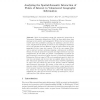Free Online Productivity Tools
i2Speak
i2Symbol
i2OCR
iTex2Img
iWeb2Print
iWeb2Shot
i2Type
iPdf2Split
iPdf2Merge
i2Bopomofo
i2Arabic
i2Style
i2Image
i2PDF
iLatex2Rtf
Sci2ools
COSIT
2011
Springer
2011
Springer
Analyzing the Spatial-Semantic Interaction of Points of Interest in Volunteered Geographic Information
With the increasing success and commercial integration of Volunteered Geographic Information (VGI), the focus shifts away from coverage to data quality and homogeneity. Within the last years, several studies have been published analyzing the positional accuracy of features, completeness of specific attributes, or the topological consistency of line and polygon features. However, most of these studies do not take geographic feature types into account. This is for two reasons. First, and in contrast to street networks, choosing a reference set is difficult. Second, we lack the measures to quantify the degree of feature type miscategorization. In this work, we present a methodology to analyze the spatial-semantic interaction of point features in Volunteered Geographic Information. Feature types in VGI can be considered special in both, the way they are formed and the way they are applied. Given that they reflect community agreement more accurately than top-down approaches, we argue that...
| Added | 18 Dec 2011 |
| Updated | 18 Dec 2011 |
| Type | Journal |
| Year | 2011 |
| Where | COSIT |
| Authors | Christoph Mülligann, Krzysztof Janowicz, Mao Ye, Wang-Chien Lee |
Comments (0)

